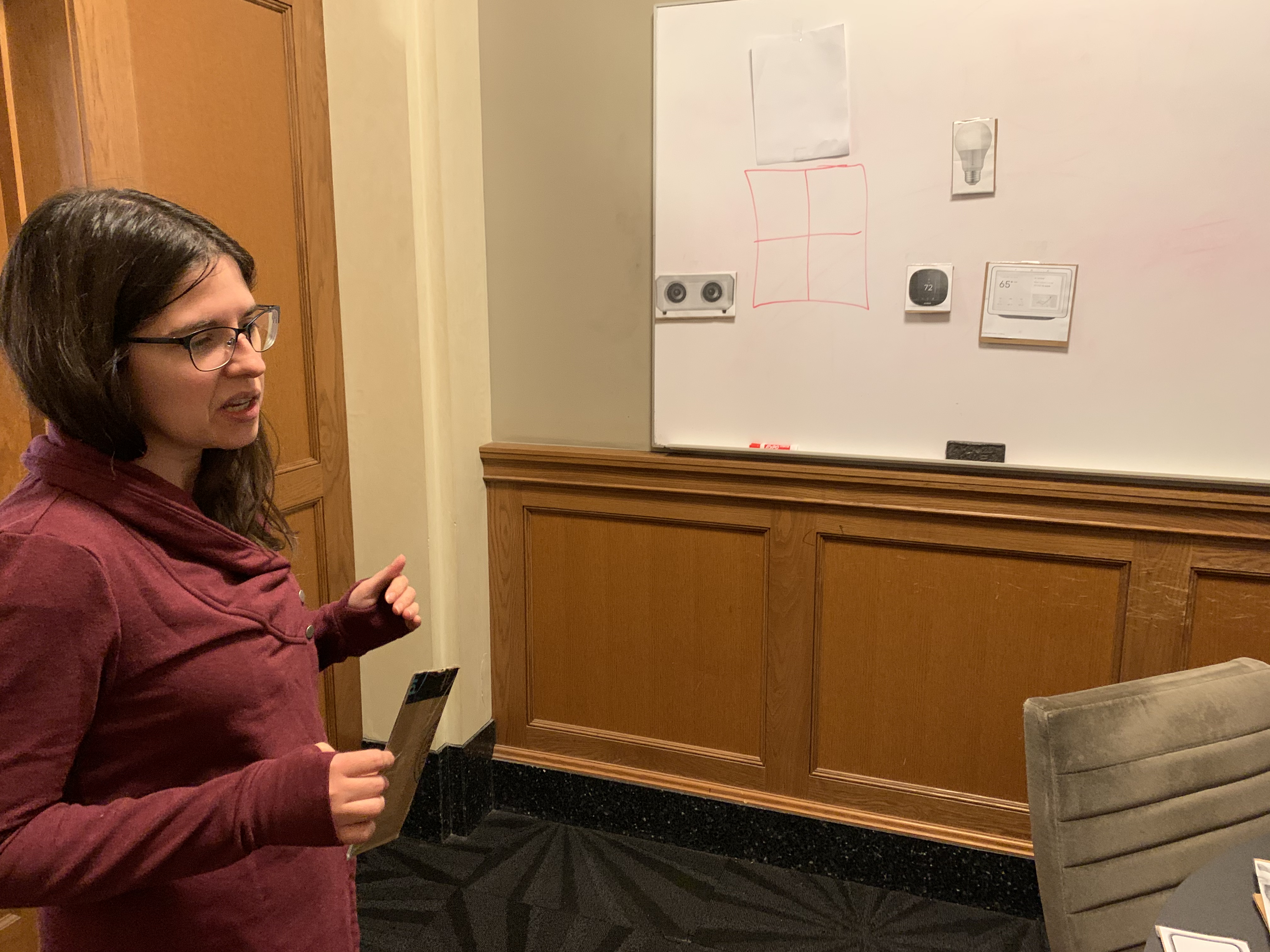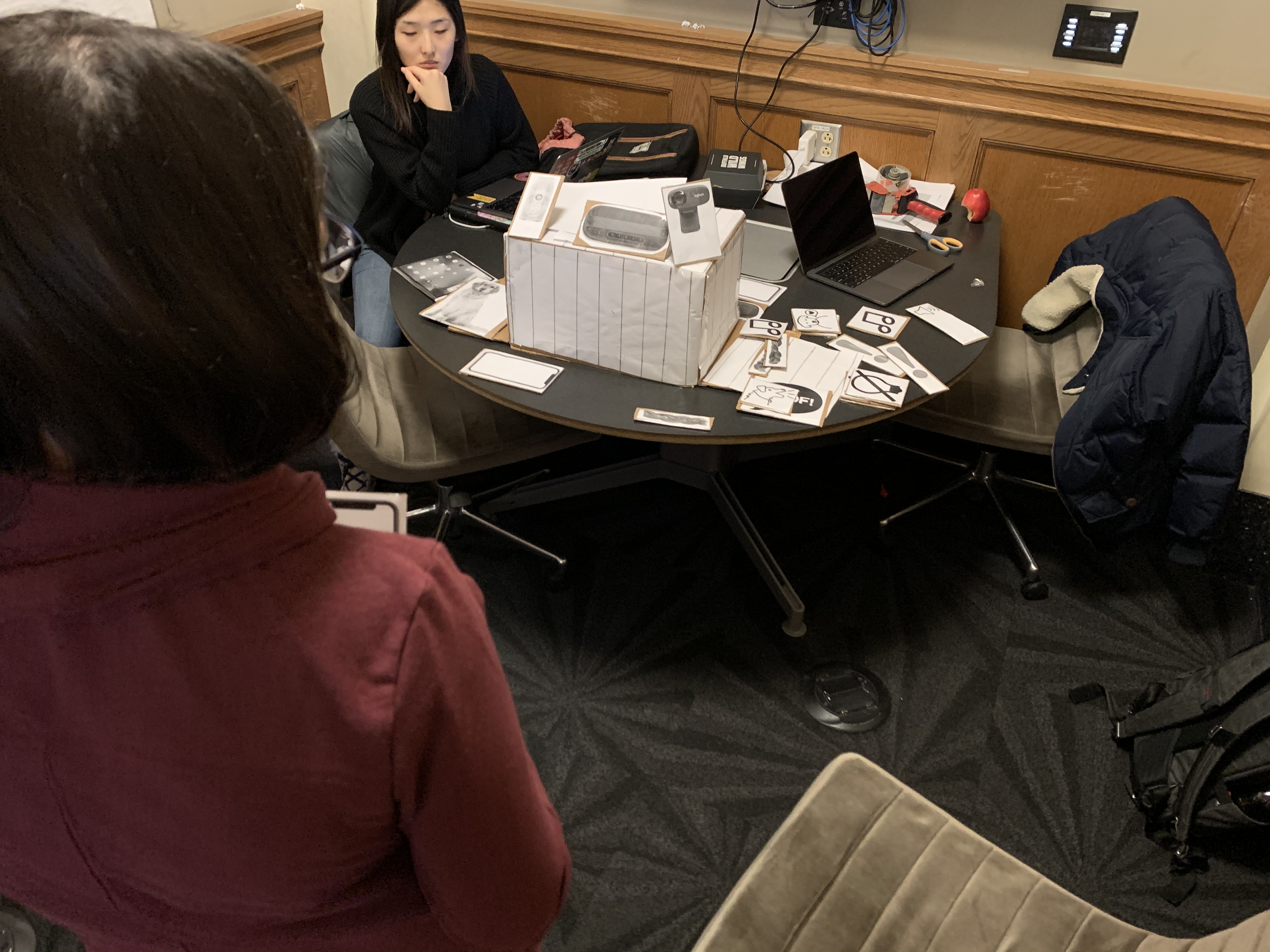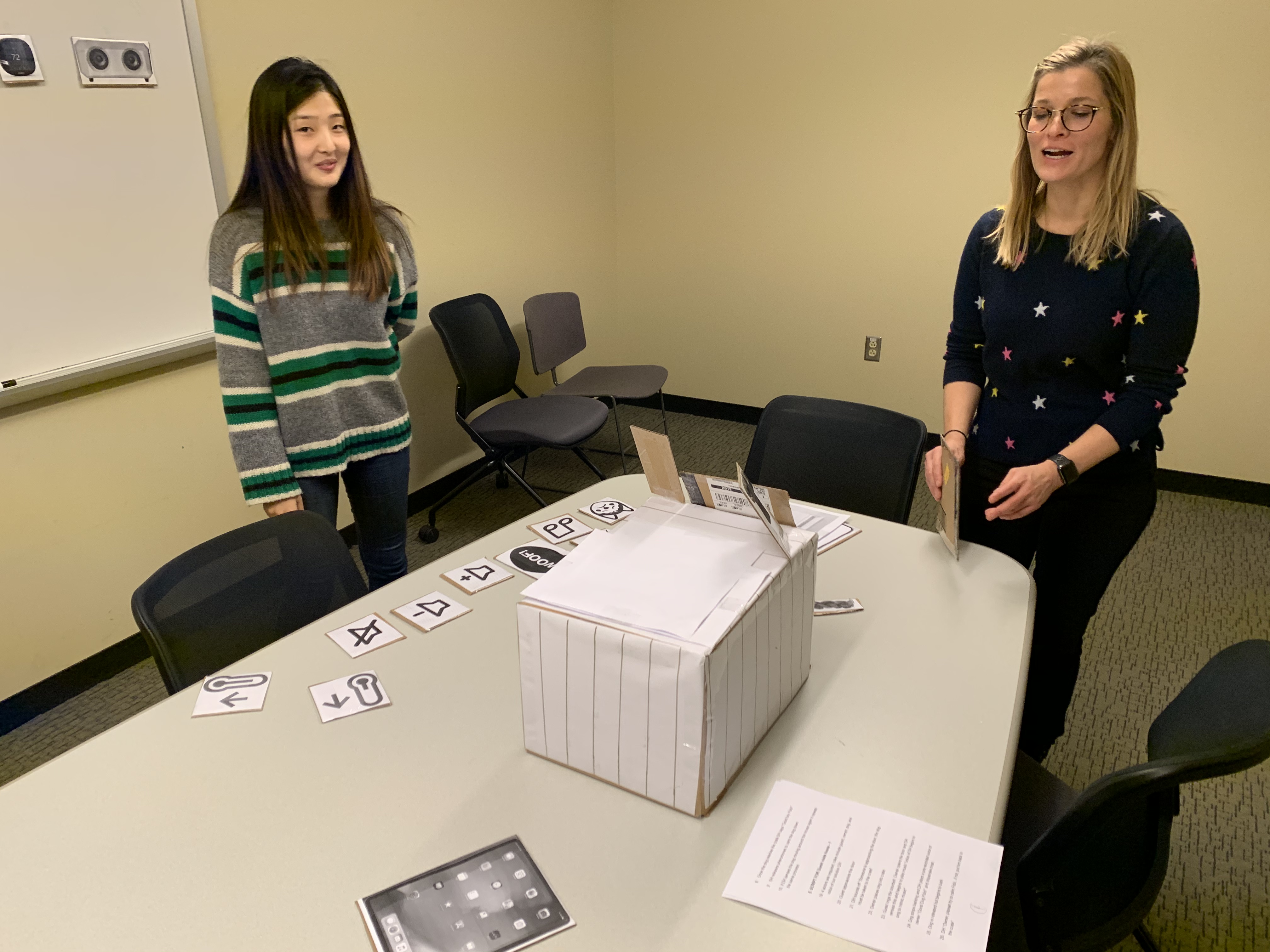Milestone 3
Introduction
For Milestone 2, we conducted a survey and diary study, and with those results, we decided to focus on discouraging dogs’ disruptive indoor barking triggered by auditory and visual stimulus. Using positive reinforcement and stimulus masking methods, we hope that our solution will train the dog when the owner is not home to provide the training themselves. Since many of these disruptive behaviors can occur with every type of dog, we decided to refine our target audience is dog owners who spend more than on average, an hour away per day from their dogs. Moving forward, we want to focus on improving the dogs’ overall behavior.
Study Design
Our experience prototyping study involved conducting five user enactments with each of our five participants for a total of 25 user enactments to answer our four research questions. Through the user enactments, we wanted to understand users’ perception and the strengths and weaknesses of our product in varying scenarios. With our enactments, we wanted to answer the following questions:
1. What smart crate features do users see themselves using at home versus when they are away from their home?
2. Does the smart crate feel invasive?
3. How much remote interactivity and automation do owners expect from their smart kennel?
4. What kind of information should be regularly available from their mobile devices?
To answer the above questions, our scenarios needed to be detailed enough for users to successfully understand and be aware of all our product’s features. On the other hand, we were also curious about how users would use our product in different enactments, if at all, when the users were not given directions. We settled for five scenarios, two of which did not require much narration besides the initial scene set-up to allow users more free reign once they had a clear understanding of our product’s features from the initial detailed enactments. Enactments 1, 2, and 3 were carried out first since they were more detailed and the less scripted enactments 4 and 5 were carried out at the end of the session.
1. Set up
Our props were made from cardboard and paper. The Dog House is essentially a smart crate that can be paired with sensors within and outside the owner’s home. Our props included a cardboard dog cage, dog, and a variety of icons and symbols to demonstrate which features were being activated by the system. For example, when the Dog House activated music playing to mask auditory stimulus that is triggering a dog’s barking, we not only had sound effects to demonstrate this, but we also included a visual indicator of music notes to represent that feature as well.
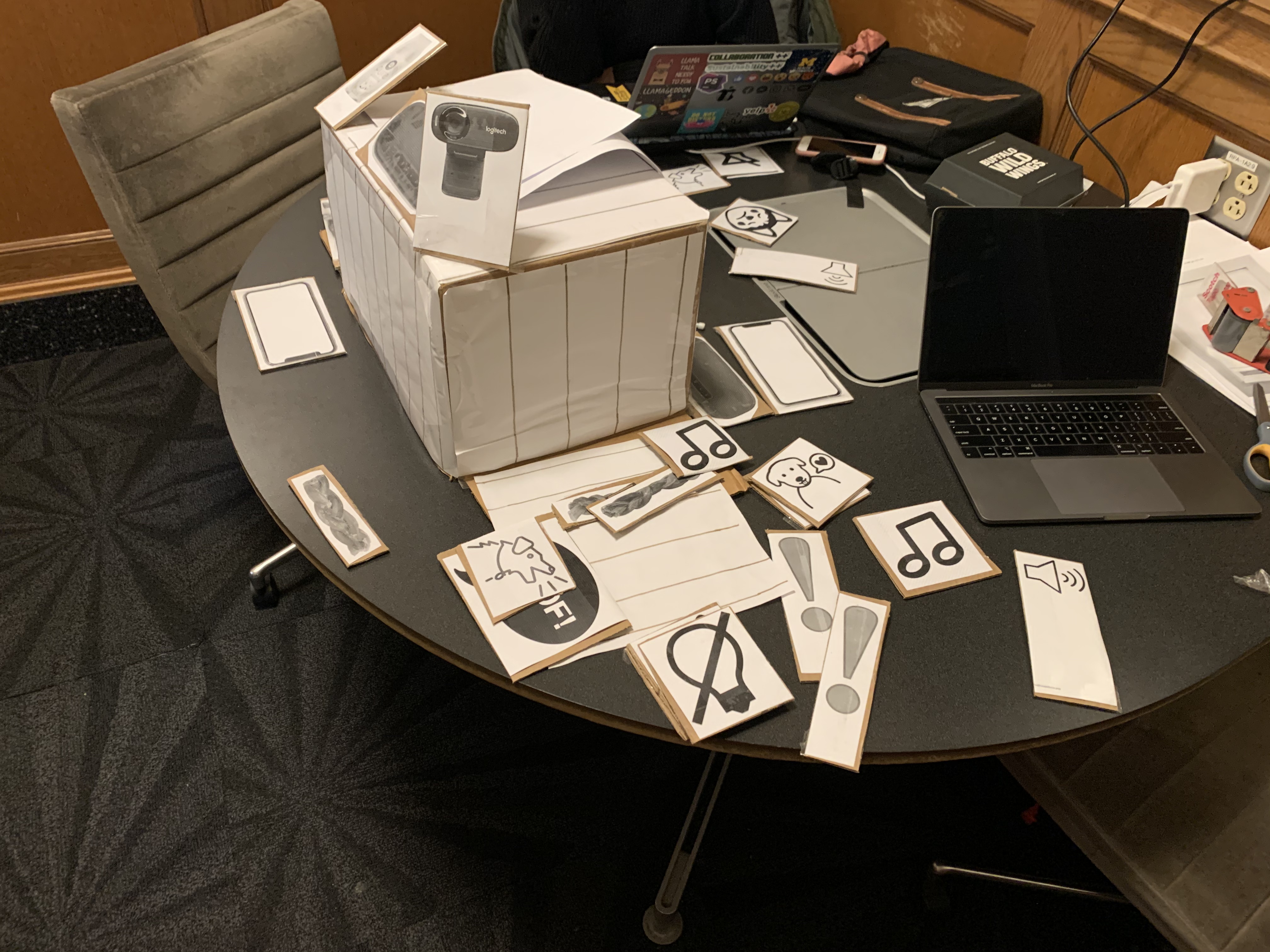
2. Enactments
After analyzing the diary study reports and surveys from milestone 2, we designed five enactments centered around activities that commonly triggered barking in dogs. Our enactments were conducted in North Quad study rooms that were converted into a mock “living spaces” where the dog owner’s smart crate was being kept. Various smart home devices were placed around the living space to better understand how the smart kennel might integrate with other connected devices and sensors in users’ homes. We were able to recruit five participants for our study and conduct a total of 25 user enactments.
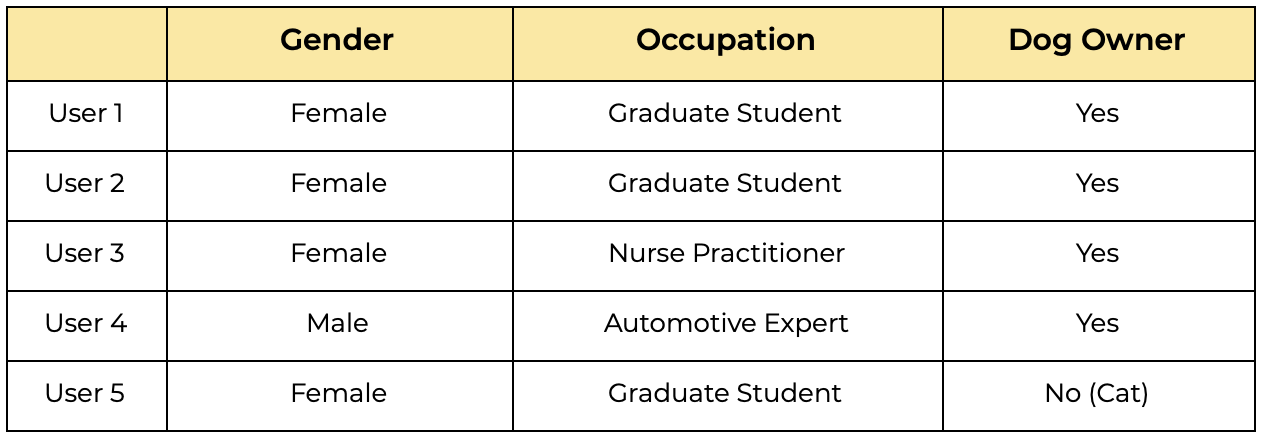
Below, the enactments are described and paired with the research questions the enactments were meant to answer. For all of our enactments, we had a narrator, a note taker, a dog owner(user) and the actor who played the parts of the dog and the Dog House system. The enactments described below were conducted in order, beginning with an initial script:
“You are a dog owner who has recently bought a dog training tool called the Dog House. The Dog House is a smart crate that can be paired with sensors within and outside the home to decrease barking in dogs. Some features include automatically dispensed treats, an audio recording system that collects information about your dog’s environment, and smart speakers. You will learn about these features in more detail through the user enactments that were created to help explore how users will view and interact with our product. Do you have any questions?”
Enactment #1: Owner Preparing for Bed
Owner gets back to their apartment at 2 AM from a night out and is getting ready for bed. Their dog is really excited and will not stop barking. Participants were instructed to utilize the smart kennel’s automated “Bed Time Mode” to help reduce the dog’s triggers. In this enactment, the Dog House trains the dog without much user input.
Research question:
- How much remote interactivity and automation do owners expect from their smart kennel?
Enactment #2 - Owner Leaves the House for Work
The owner is at work while her dog is home alone. Their dog becomes restless and the smart crate begins sending the owners notifications about how their dog is continuously barking. The dog does not stop barking for thirty minutes straight and an update is being sent to the owner every 10 minutes. When the owner comes home from work, information is sent to their phone about during what time of the day their dog’s barking was most frequent and recordings of the dog’s environment while barking was present.
Research question:
- What kind of information should be regularly available from their mobile devices?
Enactment #3 - Guest Visits Home
An unfamiliar guest who has never met their family dog is visiting the owner’s home. The Dog House attempts to prevent barking by mitigating potential stressors before they even occur. In this enactment, the Dog House will send an alert to the owner doing dishes that someone is approaching the home and the owner will be prompted to place the dog in the Dog House which will activate features that help distract and calm the dog while a guest enters the home.
Research question:
- How much remote interactivity and automation do owners expect from their smart kennel?
- What smart kennel features do users see themselves using at home vs away from the home?
Enactment #4: Owner Preparing for Bed (without narration to allow for user autonomy)
Owner gets back to their apartment at 2 AM from a night out and is getting ready for bed. Their dog is really excited and will not stop barking. The participant is instructed to utilize various features of the smart crate in any way they see fit.
Research question:
- What smart kennel features do users see themselves using at home vs away from the home?
Enactment #5 - Owner is Away and Dog Hears a Noise (without narration to allow for user autonomy)
Participants were instructed to react and respond to the notifications stating their dog is continuously barking while the owner was away from their home. The alerts state that their dog is being triggered by the noise made by garbage trucks outside their home. The owner is given the power to activate any features of the Dog House to decrease their dog’s barking.
Research question:
- Does the smart kennel feel invasive?
- What smart kennel features do users see themselves using at home vs away from the home?
- What kind of information should be regularly available from their mobile devices?
3. Debriefing
After each enactment, we reviewed our notes and thought about how our user enactments can be changed to produce more fruitful data. During the debriefing of our two initial sessions, we learned that we were only able to thoroughly answer three of our four research questions and therefore, we decided that for the last three remaining sessions, we will tweak our last two user enactment scenarios to be more loosely scripted. After the changes, we were successfully able to answer our fourth question “what smart kennel features do users see themselves using at home vs away from the home?”
Study Results and Findings
While earlier research informed us about user’s general pain points, it was in this stage of our research that we were able to directly observe users interacting with our product in the way they would in their home. As a result, we were able to observe the user's authentic reaction to our suggested features, rather than our abstract ideas or hypotheticals. It was these reactions that helped us gain a more accurate understanding of if and how our ideas were addressing user needs and the pain points we had previously identified. Additionally, we were able to gather more information about what constraints must be considered when designing our product. The following represent our synthesized study results, a paraphrased quote based on user responses, and the design implications as they relate to our final concept.

Finding 1: Owners would like to have more control over the system, and rely less on automation
Our original concept relied heavily on automation and included features that would automatically react to a variety of situations, such as releasing the dog from the kennel once it has calmed down after a period of high energy. However, our users expressed concern about these features and how their lack of involvement would affect the training process. Concerns ranged from practical considerations (could the automatic features trigger at inappropriate times and result in the dog getting into trouble?) to more emotional reactions (Would the dog like the crate more than me?).
Key insight:
“My dog won’t respond to this feature, so I want to tell the system to use a different one instead.”
Design Implications:
- Initial setup of system should include a process to learn user’s preferences for automated vs manual features
- System should use companion application to notify user when taking action, and give the owner the opportunity to stop or “snooze” the action if it’s not what they want
- Automated features should still be available for users that like them, but should not be the default
Finding 2: Being unable to react is just as bad as being uninformed
Our previous research indicated to us that owners wanted to receive notifications about what the smart kennel was doing and the wellbeing of their dog throughout the day. While this is still the case, the results from the user enactments indicated that without an opportunity to intervene when the system detects stress or activity, notifications would only make owners feel anxious or powerless. Participants expressed a desire to feel “in-control” of the event the system detects a problem. Other concerns included accessibility and connectivity issues that could result in delayed notifications or a lack of response options.
Key insight:
“If I can’t do anything about it, I’ll be worried all day.”
Design Implications:
- Notifications should be solution-oriented and give the owner a sense of agency
- System should have alternate means of communication with the owner, such as SMS, if the application isn’t working.
Finding 3: Data is king
While it was clear that owners wanted notifications from the system, they indicated that they would want more from the companion phone application. Specifically, owners expressed that they would like to have access to the data collected by the system in order to be more informed about the dog’s activity, identify patterns and design an appropriate intervention, and monitor their progress over time. Participants were particularly interested in seeing visualizations of their data to quickly and easily assess the information and react accordingly.
Key insight:
“Sometimes when we have a bad day, I just want to know that we’re still making progress”
Design Implications:
- Companion app should aggregate and display information in the form of graphs or other easy-to-read visualizations
- Companion app should make it easy for owners to identify patterns in order to adjust their training regimen
- Companion app should utilize data to show progress and aim to motivate the user
- The system, including the companion application, should be transparent about the data it collects and make it easy for the user to locate and use the data
Finding 4: The system should train the owner as much as it trains the dog
All participants acknowledged that training a dog was difficult, but rather than focusing exclusively on the system to completely remove the burden of training, they sought a product that would help them be a better trainer. Some participants cited the struggles they faced when training their dogs, such as not giving in to barking and whining when their dog was first introduced to the crate. Others acknowledged that many owners lack knowledge, not motivation, and could use additional training support.
Key insight:
“I want to do the right thing, but sometimes I don’t know what the right thing is”
Design Implications:
- The system should have the ability to use the data it gathers to make recommendations to the owner
- The companion app should aim to educate the user when it makes a recommendation, rather than just supplying the recommendation
- The companion app should use user input and available data to show the user’s progress, as well as the dog’s
Ideation and Selection
Ideation for this milestone began with each member of our group reviewing the notes from the user enactments and drawing their own conclusions. In a subsequent meeting, we shared our individual interpretations with one another and using a group brainstorm in which we identified the similarities and differences between each other’s ideas. Upon reaching a consensus about what we felt the most important findings were, we then used this information to develop the primary trade-offs and criteria for our new design.
Trade offs
While the information gathered from the user enactments validated some of our earlier findings, they also demonstrated that there were some features that were less important to our users. Due in part to our own time constraints and the scope of the overall project, we analyzed what trade offs could be made that would improve the overall user experience. Below you will find the trade-offs we identified:
- In order to allow for more customization, automated features would not come standard and as a result would require a more comprehensive setup process- Users expressed that some core features--such as distributing treats and using sounds to soothe the dog--were useful, but could be more robust. As a result, we have chosen to limit the number of features in favor of increasing the overall quality and usability of the features identified by our users as most important.
- Due to our user’s requests for additional training support, we have decided to sacrifice some of the features we developed as a part of our original concept that focused on augmenting the home environment in favor of new features that would better augment the training process.
Criteria
In order for our product to meet our user’s needs, we have identified the following criteria by which we consider each new feature:
Training-focused: The system and its features should focus on augmenting the training process, not the space in which it takes place. While sensors and other pervasive elements are necessary, the system should focus on solving the problems experienced by the owner during the training period rather than automating the process without owner’s input.Educational: Training is challenging, and as a result, the system’s features should aim to educate the owner with recommendations, data visualization, and training tips and tricks. The features are designed to train both dog and owner, rather than simply automating the training process independently.
Encourages Agency: Users must have control over automatable features, and the system should empower the user to make decisions that affect their companion and the training process rather than making decisions for them.
Data-Driven: Recommendations, tips, notifications, and other features in the system should be made based on data collected by the DH or from reliable outside sources. Data must be accessible to the user in order to keep them informed and allow them to make data-driven decisions.
Adaptive: The system should adapt to the changing environmental factors, such as the presence of the owner or other people, outside stimulus, etc. Additionally, the system must recognize changes in the dog’s behavior and must adapt to dog’s progress over time.
System Proposal
We are proposing a smart kennel that will help facilitate crate training with the dog owner. The smart kennel will allow users to interact and monitor their dog from anywhere in the world from their smartphone or tablet. Initially, the smartphone app will walk the dog owner through various The smart kennel will allow the user to track and analyze the dog’s emotional triggers, as well as remotely control various functions, including accessing the live camera, playing music or their voice through the smart kennel’s speaker, and dispersing a dog’s treat.
Storyboard 1
Our first storyboard depicts a user when she first gets the DH and she is unsure of how she wants to use the automated features of the system. She opens the companion smartphone app to begin setup, and discovers that the onboarding process in the app presents her with scenarios in which the system could take action, and lets her choose the option that best fits her needs. Upon completing the setup process, she is confident that the system will now meet her needs and that she has set it up just the way she likes it.
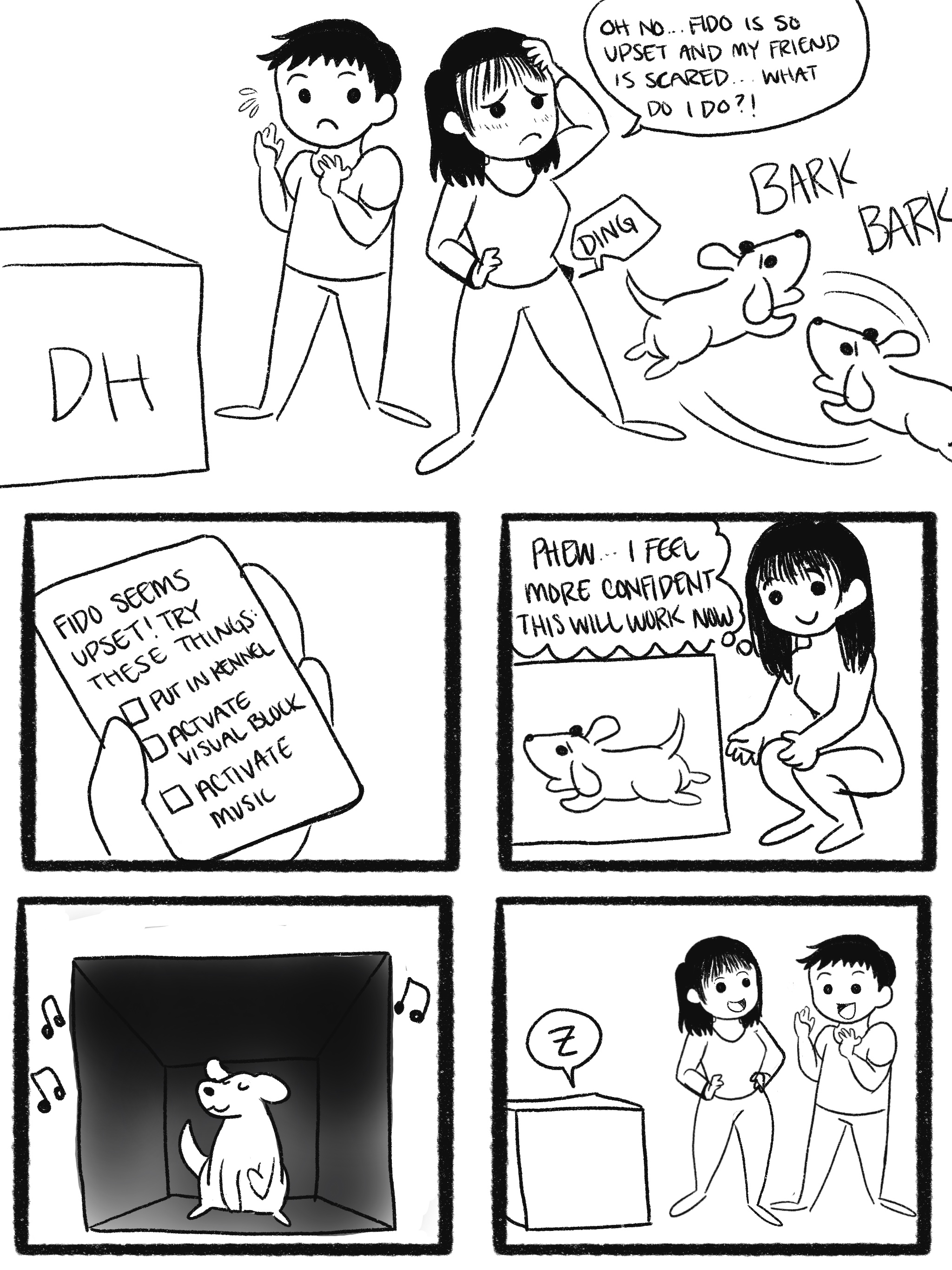
Storyboard 1
Storyboard 2
In our second storyboard, we can see how the system gives the owner the option to respond and makes recommendations for how to do so. Our user has a guest over, and her dog is barking and acting out now that there is a new person in the house. She realizes that her dog is stressed and her guest is uncomfortable, but isn’t sure what to do to resolve the situation. Detecting the dog’s movement and stress levels through its sensors, the DH sends her a notification for what she can do. The system recommends she places the dog in the crate and activates two calming features, and she follows through and does these things. When she’s doing them, she feels more empowered since the system gave her suggestions but let her make her choice. She then goes on to enjoy a visit with her friend while the dog relaxes in the crate.
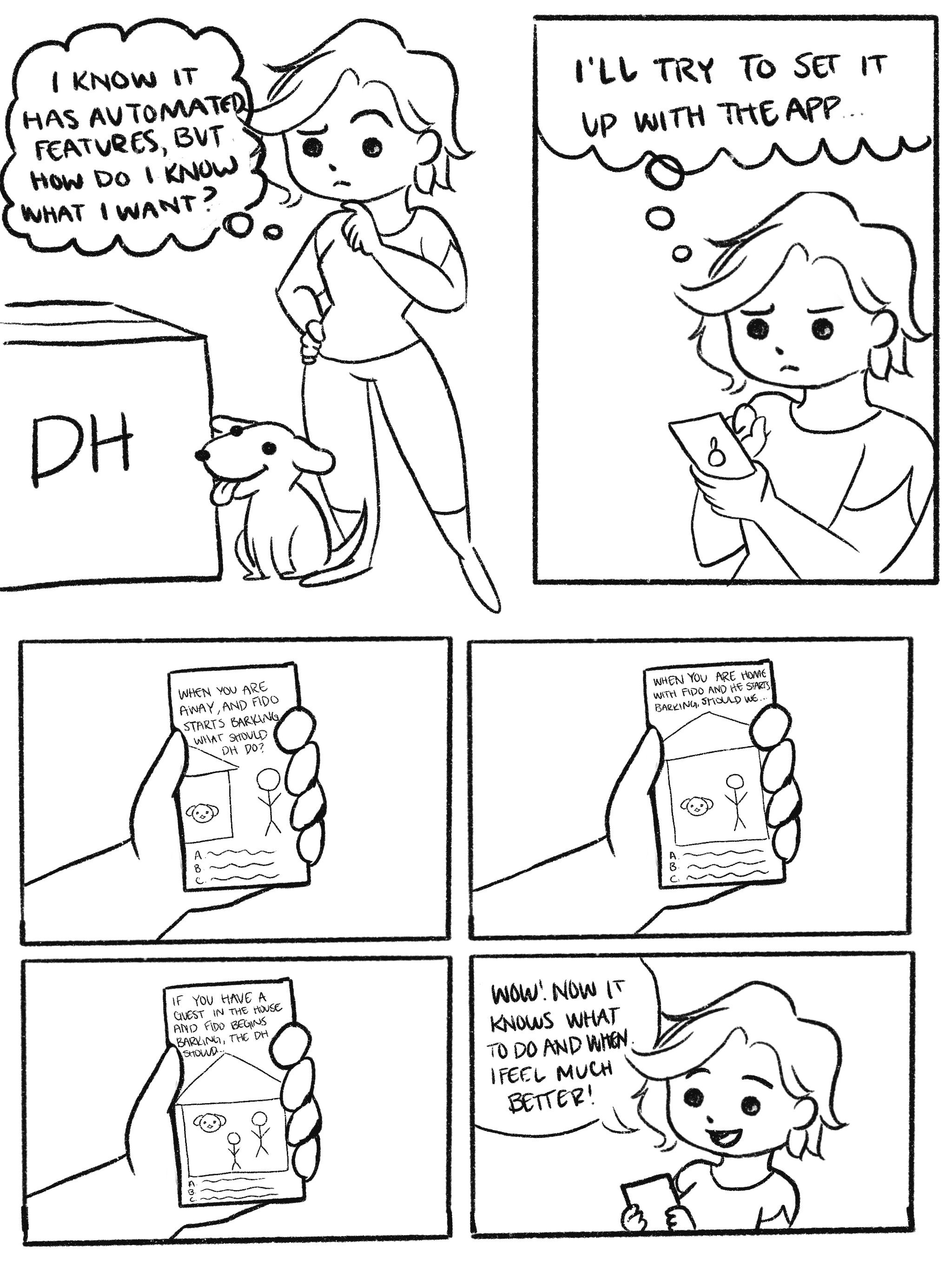
Storyboard 2
System architecture
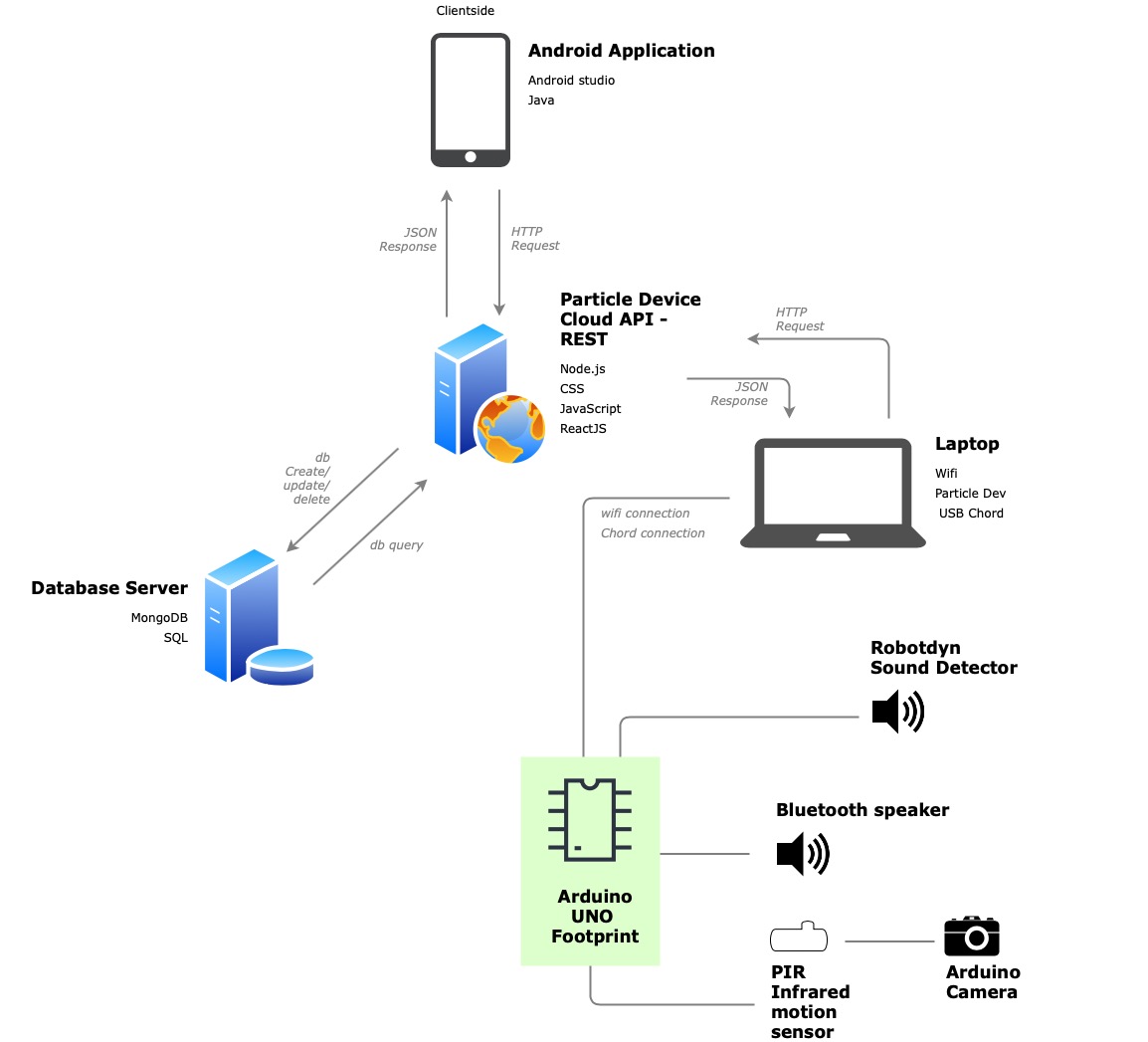
System architecture
Materials we need for demo
Hardware:
- Database Server, Particle Cloud API REST Webserver, Android phone, Laptop, Wi-Fi, Arduino UNO Footprint, Robotdyn Sound Detector, PIR Infrared Motion Sensor, Bluetooth speaker, Breadboard, Male-Female Jumper wires, Male-Male Jumper wires, Bi-directional logic level convertor , Red Blue Green LED, Resistor 4.7 Ω - 120 Ω
Software:
- Particle Dev, Android Studio, Figma Prototyping Tool
Other:
- Cardboard box, cardbox cutouts
Particle Cloud API REST Web server: The Particle Device Cloud API is a REST API. REST means a lot of things, but first and foremost it means that we use the URL in the way that it's intended: as a "Uniform Resource Locator". In this case, the unique "resource" in question is your device (Core, Photon, Electron). Every device has a URL, which can be used to GET variables, POST a function call, or PUT new firmware. All requests to the device come through our API server using TLS security. Android app: We are using an Android app to send notifications from the Dog House to the owner’s phone. Owner should be able to receive notification when the crate door opens/closes, the dog is barking, etc. Android Studio: Android Studio is the official integrated development environment (IDE) for Android application development. We will be using Android Studio to develop our Android application.Demo proposal
For our demo, we will be focusing on the experience of the user interacting with the smart kennel through a mobile device, including how the smart kennel will help aid users in crate training, data visualization of information related to the dog’s triggers, and how the user would trigger various functions that are available on the kennel. We plan on using a prototyping tool like Figma to simulate the crate training system and accompanying data, as well as viewing the kennel’s camera, playing various music and recordings, and dispersing a dog treat.
The two biggest barriers for implementing various functions in the smart crate is related to time and technical skill - creating a physical prototype that utilizes many different sensors can be difficult to implement, especially ones that involve physical changes to the kennel like closing or opening the blinds and opening the kennel’s door. Our prototype will focus on the visual and auditory connection between the owner and their dog through a video camera, speaker, and noise detector.
Conclusion
The user enactment studies helped us collect information on how users’ perceived our product and forced us to think about the strengths and weaknesses of our product in varying situations. We narrowed our scope further by eliminating features that users perceived as not particularly useful and solidified the idea that our product which is essentially a dog training tool was meant to augment and not replace the owner involvement. We came to this conclusion because in many of the enactments, user wanted more control over the system and rely less on automation. We also observed that a target audience will always have varying different needs. Features that might satisfy one group of people might seem unnecessary to another. These two findings led us to the importance of customization such as implementations of initial system setup that includes a process to learn users’ preferences for automated versus manual features.
